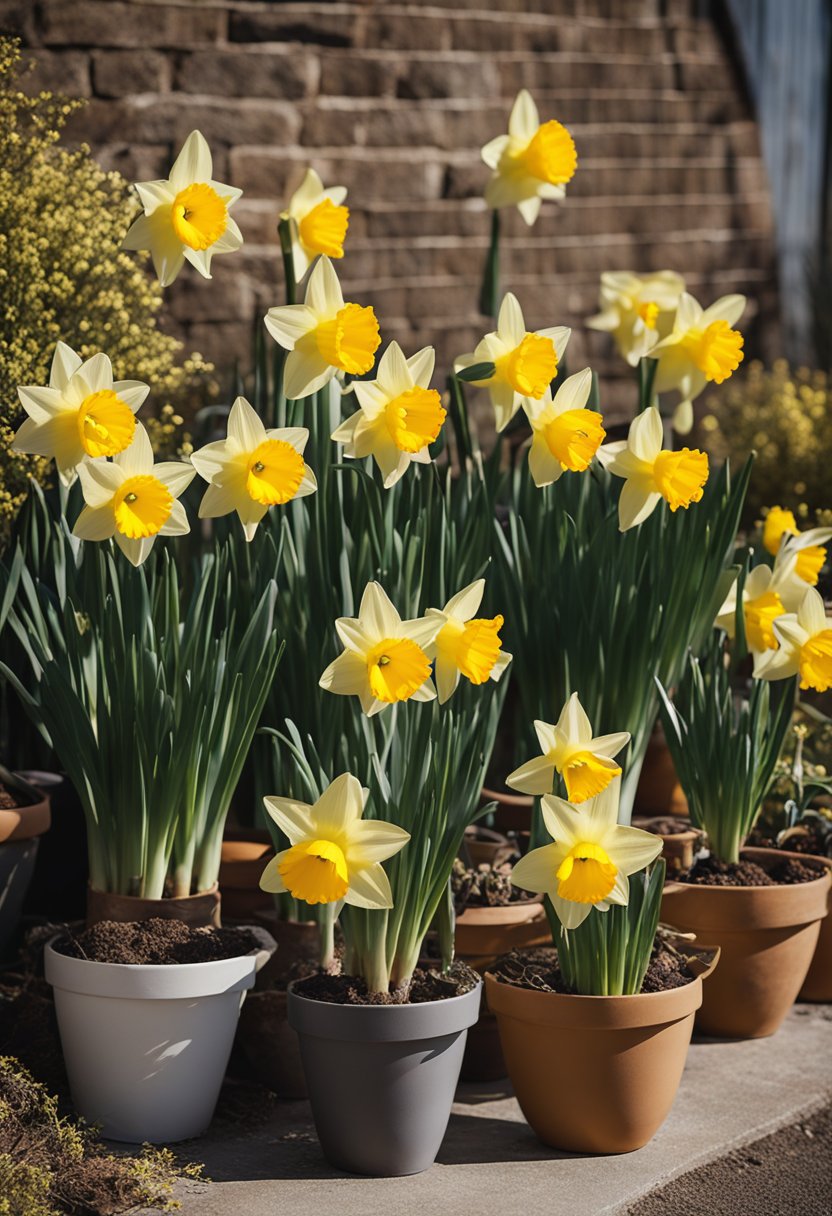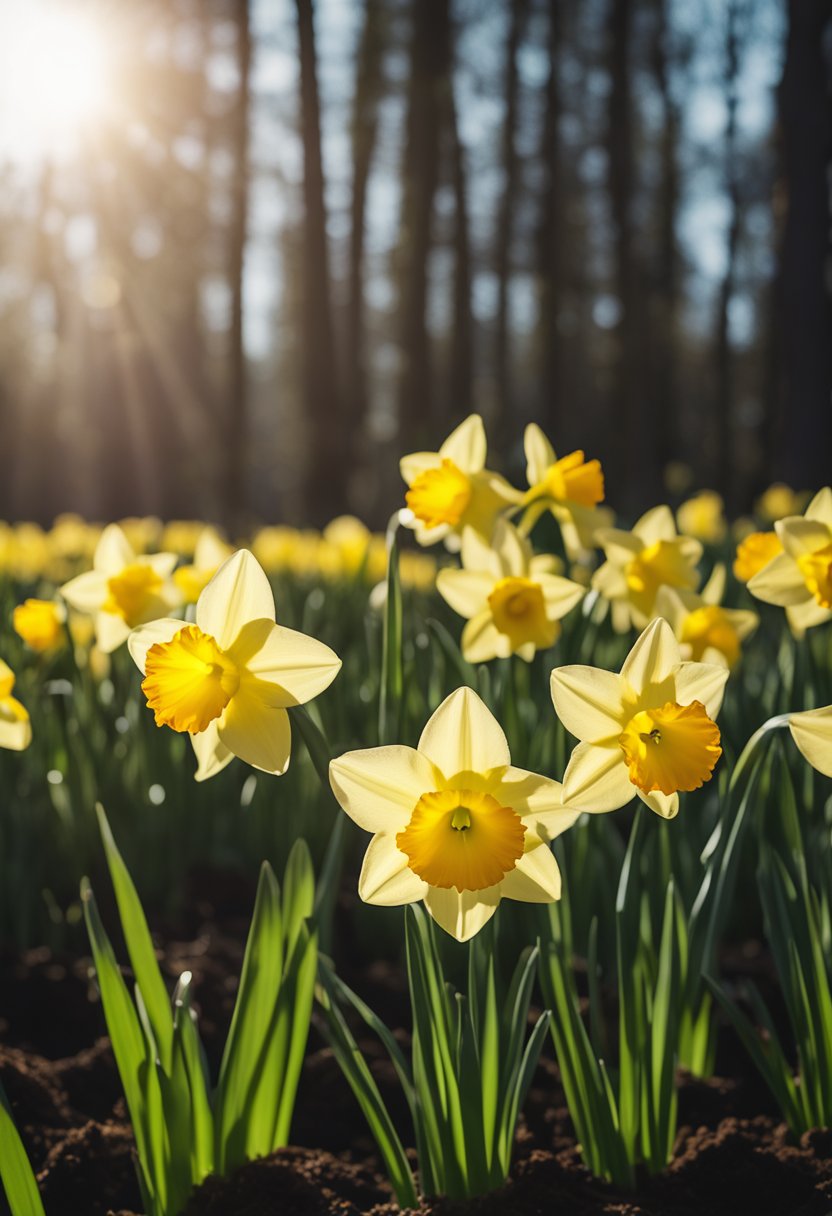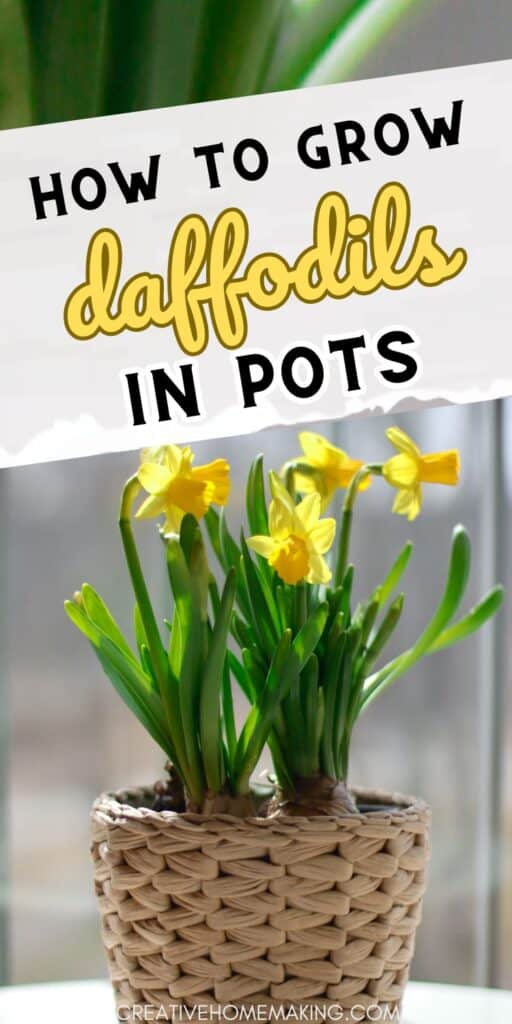Growing daffodils in pots is a great way to add some color and life to your outdoor space. Whether you have a small balcony or a large patio, daffodils can bring a touch of spring to your home.
This post may contain affiliate links.
In this article, we’ll give you some tips on how to grow daffodils in pots, so you can enjoy these beautiful flowers all year round.
The first thing you need to do is choose the right pot. Daffodils need well-draining soil, so make sure your pot has drainage holes at the bottom.
You can use any type of pot, but terracotta pots are a popular choice as they are porous and allow the soil to breathe. Make sure your pot is big enough to accommodate the bulbs and has enough depth for the roots to grow.
Related Article: How to Grow Blueberries in Pots
Once you have your pot, it’s time to choose your bulbs. Daffodils come in many different varieties, so choose the ones that best suit your space and your taste.
You can plant your bulbs in the fall or early winter, so they have time to root before the spring. Plant them about 3-4 inches deep and 3-4 inches apart, and cover them with soil.
Water them well and place them in a sunny spot. With a little care and attention, you’ll soon have beautiful daffodils blooming in your pots.
Related Article: When to Plant Flowers for Spring: A Helpful Guide
Choosing the Right Daffodil Varieties
When it comes to growing daffodils in pots, selecting the right daffodil varieties is crucial for their growth and development. Here are some things to consider when choosing which daffodils to grow in your pots.
Understanding Daffodil Types
Daffodils come in many different types, including trumpet, double, and miniature varieties. Trumpet daffodils have a large trumpet-shaped center and are the most commonly grown type.
Double daffodils have multiple layers of petals and are often larger than other varieties. Miniature daffodils are smaller and more delicate, making them perfect for smaller pots.
Related Article: Growing Lemon Balm in Pots
Selecting Pots for Different Daffodil Sizes
When choosing pots for your daffodils, it’s important to consider the size of the bulbs and the type of daffodil you’re growing. Larger bulbs will require larger pots to accommodate their growth, while miniature daffodils can thrive in smaller pots.
Yellow, white, orange, and pink are some of the most popular colors for daffodils. However, there are many different varieties available, each with its own unique color and appearance. Consider the color scheme of your garden or home when selecting which daffodil varieties to grow.
Preparing the Pot and Soil
When growing daffodils in pots, it is important to prepare the pot and soil properly to ensure healthy growth and vibrant blooms. Here are some tips on how to prepare the pot and soil for your daffodils.
The Importance of Good Drainage
Good drainage is crucial for growing daffodils in pots. Without it, the roots can become waterlogged and rot, which can lead to stunted growth or even death of the plant.
To ensure good drainage, choose a pot with drainage holes in the bottom and place a layer of gravel or broken pottery in the bottom of the pot before adding soil.
Related Article: Growing Grapes in Pots
Soil Composition and Nutrients
Daffodils prefer sandy, slightly acidic soil that is well-drained. You can create this type of soil by mixing together equal parts of sand, peat moss, and perlite or vermiculite. Alternatively, you can use a pre-made potting mix that is specifically formulated for bulbs.
It is important to fertilize your daffodils regularly to ensure healthy growth and vibrant blooms. You can use a balanced fertilizer, such as a 10-10-10 formula, or a fertilizer specifically formulated for bulbs.
Be sure to follow the instructions on the package carefully to avoid over-fertilizing, which can damage the roots.
By preparing the pot and soil properly, you can give your daffodils the best possible start and enjoy beautiful blooms in the spring.

Planting Daffodils in Pots
If you want to enjoy the beauty of daffodils but don’t have a garden, planting them in pots is a great option. Not only will you be able to enjoy their vibrant colors and sweet fragrance, but you can also move the pots around to find the perfect spot for them. Here’s how to plant daffodils in pots.
When to Plant Daffodil Bulbs
Daffodils are usually planted in the autumn, but you can also plant them in the spring. If you’re planting them in the autumn, do so before the first frost. If you’re planting them in the spring, do so as soon as the ground thaws.
Related Article: Care for Potted Tulips: Tips for Keeping Your Blooms Beautiful
How to Plant Daffodil Bulbs
To plant daffodil bulbs in pots, follow these steps:
- Choose a pot that is at least 6 inches deep and has drainage holes.
- Fill the pot with potting soil, leaving about 2 inches of space at the top.
- Dig a hole in the soil that is about twice as deep as the bulb.
- Place the bulb in the hole with the pointed end facing up.
- Cover the bulb with soil and press down gently.
- Water the soil thoroughly.
Depth and Spacing for Bulbs
When planting daffodil bulbs in pots, the depth and spacing will depend on the size of the pot and the number of bulbs you’re planting.
As a general rule, bulbs should be planted at a depth that is two to three times their height. For example, if the bulb is 2 inches tall, it should be planted 4-6 inches deep. As for spacing, bulbs should be planted at least 2-3 inches apart to allow for proper growth.

Caring for Potted Daffodils
Growing daffodils in pots is a great way to enjoy their bright, cheerful blooms even if you don’t have a garden.
To ensure that your potted daffodils stay healthy and produce beautiful blooms, it’s important to provide them with the right care. Here are some tips for caring for your potted daffodils:
Sunlight and Temperature Requirements
Daffodils prefer full sun or partial shade, so make sure to place your pots in a location that receives at least six hours of direct sunlight per day. They also prefer cooler temperatures, ideally between 50 and 60 degrees Fahrenheit.
If the temperature gets too hot, your daffodils may wilt and their blooms may fade quickly.
Watering and Fertilizing Schedule
Daffodils in pots need regular watering to keep their soil moist but not waterlogged. Check the soil regularly and water when the top inch feels dry to the touch. Be careful not to overwater, as this can lead to bulb rot and other problems.
Fertilizing is also important for healthy daffodil growth. Use a balanced fertilizer once a month during the growing season (spring and early summer). Follow the instructions on the package carefully to avoid over-fertilizing, which can damage your daffodils.
Protecting Against Pests and Diseases
Daffodils are generally healthy plants, but they can be susceptible to certain pests and diseases. Nematodes, slugs, and snails are common pests that can damage your daffodils.
To protect against these pests, keep your pots clean and remove any dead leaves or debris that could attract them.
Bulb rot is a common disease that can affect daffodils in pots. To prevent bulb rot, make sure your pots have good drainage and don’t let them sit in water.
If you notice any signs of bulb rot (such as soft or mushy bulbs), remove the affected bulbs and replant the healthy ones in fresh soil.
Enjoying the Blooms
Once your daffodils have bloomed, it’s time to sit back and enjoy their beauty. Here are a few things to keep in mind to help you get the most out of your blooms.
When to Expect Blooming
Daffodils typically bloom in the early spring, depending on your climate and the variety you’ve planted. You can expect blooms to last for about two weeks, so be sure to take plenty of photos while they’re at their peak.
Deadheading and Post-Bloom Care
Once your daffodils have finished blooming, it’s important to deadhead them to encourage future growth. Simply snip off the spent blooms, being careful not to damage the leaves or stem. You can also remove any yellowing foliage at this time.
To help your daffodils prepare for next year’s bloom, continue to water and fertilize them until the foliage dies back naturally.
This will help the bulbs store energy for next year’s growth.
Frequently Asked Questions
How do you care for daffodils grown indoors in containers?
Daffodils grown indoors in containers require proper care to thrive. Make sure the containers have good drainage and are filled with well-draining soil.
Water the bulbs regularly, but avoid overwatering as it can lead to root rot. Place the containers in a location that receives plenty of sunlight. Fertilize the bulbs with a balanced fertilizer every two weeks during the growing season.
What’s the best way to overwinter daffodils planted in pots?
To overwinter daffodils planted in pots, you should move the containers to a cool, dark location where the temperature remains between 35-45°F (2-7°C).
Stop watering the bulbs after the foliage has died back, and allow them to rest for several months. In the spring, move the containers to a sunny location and resume watering.
What steps should be taken after daffodils have bloomed in containers?
After daffodils have bloomed in containers, you should remove the spent flowers to prevent the bulbs from wasting energy on seed production.
Allow the foliage to die back naturally, and continue to water the bulbs regularly. Fertilize the bulbs with a balanced fertilizer every two weeks during the growing season.
What is the ideal watering schedule for daffodils in containers?
The ideal watering schedule for daffodils in containers is to water them when the top inch of soil feels dry to the touch. Avoid overwatering, as it can lead to root rot. Make sure the containers have good drainage to prevent water from pooling at the bottom.
How deep should daffodil bulbs be planted in containers?
Daffodil bulbs should be planted in containers at a depth of 4-6 inches (10-15 cm). Make sure the bulbs are spaced at least 2 inches (5 cm) apart to allow for proper growth.
When is the optimal time to plant daffodil bulbs in containers?
The optimal time to plant daffodil bulbs in containers is in the fall, before the first frost. This allows the bulbs to establish roots before winter and bloom in the spring.
If you missed the fall planting window, you can also plant the bulbs in early spring, but they may not bloom until the following year.
Follow my gardening board on Pinterest.



